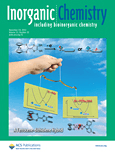
INORGANIC CHEMISTRY
Scope & Guideline
Illuminating the Dynamics of Inorganic Materials
Introduction
Aims and Scopes
- Synthesis and Characterization of Inorganic Compounds:
Research articles in this area discuss novel methods for synthesizing inorganic materials, including coordination compounds, metal-organic frameworks (MOFs), and transition metal complexes, often detailing their structural and physicochemical properties. - Catalytic Applications of Inorganic Materials:
This scope covers studies on the catalytic performance of inorganic compounds in various chemical reactions, such as hydrogen evolution, CO2 reduction, and organic transformations, highlighting their potential in green chemistry and energy applications. - Photocatalysis and Photochemical Processes:
Research on the use of inorganic materials as photocatalysts for environmental remediation, energy conversion, and chemical synthesis is a prominent theme, focusing on the design of materials that can effectively harness solar energy. - Nanomaterials and Nanostructures:
The journal includes advancements in the development of nanoscale inorganic materials, exploring their unique properties and potential applications in areas such as sensing, catalysis, and energy storage. - Interdisciplinary Research in Inorganic Chemistry:
There is a consistent focus on the intersection of inorganic chemistry with other fields, such as biology, materials science, and environmental science, showcasing the diverse applications of inorganic compounds.
Trending and Emerging
- Sustainable Energy Solutions:
Research related to energy storage, conversion, and sustainable practices, particularly involving lithium-ion and sodium-ion batteries, has gained significant traction, reflecting the global push towards clean energy. - Advanced Materials for Environmental Applications:
There is an increasing focus on synthesizing and characterizing materials for pollutant degradation, CO2 capture, and water purification, addressing urgent environmental challenges. - Bioinorganic Chemistry:
Research that connects inorganic compounds with biological systems, including drug delivery systems and biomaterials, is on the rise, reflecting the interdisciplinary nature of modern chemistry. - Functional Nanomaterials:
The development of novel nanostructured materials for applications in electronics, catalysis, and sensing is a prominent theme, showcasing the innovative directions in materials science. - Metal-Organic Frameworks (MOFs) and Their Derivatives:
Research on MOFs, particularly their functionalization and applications in gas storage, separation, and catalysis, is increasingly popular, capitalizing on their tunable properties.
Declining or Waning
- Traditional Coordination Chemistry:
Research focusing solely on classical coordination complexes with limited applications has seen a decline, as the field shifts towards more innovative and application-driven studies. - Inorganic Solid-State Chemistry:
The exploration of traditional solid-state materials without a focus on their functional applications has decreased, giving way to more dynamic research on functional materials. - Basic Inorganic Theory and Concepts:
Papers centered on fundamental theoretical aspects of inorganic chemistry, without practical applications or novel insights, are becoming less frequent, as researchers prioritize applied and interdisciplinary studies.
Similar Journals
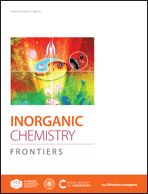
Inorganic Chemistry Frontiers
Unlocking Innovations in Inorganic ChemistryInorganic Chemistry Frontiers, published by the esteemed Royal Society of Chemistry, stands at the forefront of advancements in the field of inorganic chemistry, boasting a prestigious Q1 ranking in its category as of 2023 and an impressive Scopus Rank of #3 out of 79, placing it in the 96th percentile. Since its inception in 2014, this journal has provided a robust platform for high-quality research that spans the diverse and rapidly evolving areas of inorganic chemistry. As an open-access journal, it ensures that the findings presented are readily accessible to researchers, educators, and practitioners globally, fostering an inclusive environment for the dissemination of knowledge. With its rigorous peer-review process, Inorganic Chemistry Frontiers aims to facilitate interdisciplinary dialogue and innovation, making it an essential resource for anyone dedicated to exploring the myriad applications and theoretical advancements within inorganic chemistry.
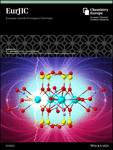
EUROPEAN JOURNAL OF INORGANIC CHEMISTRY
Exploring the Frontiers of Inorganic ChemistryThe EUROPEAN JOURNAL OF INORGANIC CHEMISTRY, published by WILEY-V C H VERLAG GMBH, is a premier peer-reviewed journal dedicated to advancing the field of inorganic chemistry. With an ISSN of 1434-1948 and an E-ISSN of 1099-0682, this journal has established itself as a key platform for the dissemination of innovative research, reviews, and features since its inception. As of 2023, it holds a respectable Q2 quartile ranking in the domain of inorganic chemistry, reflecting its influence and contribution to the scientific community—ranking #33 out of 79 in Scopus’ assessment and placing the journal in the 58th percentile. The journal encompasses a wide range of topics within inorganic chemistry, making it a valuable resource for researchers, professionals, and students alike. Although the journal does not currently offer open access, it remains an essential outlet for high-quality, impactful studies in inorganic chemistry, showcasing significant advancements and fostering collaboration among scholars globally.

TRANSITION METAL CHEMISTRY
Navigating the Evolving Landscape of Transition MetalsTransition Metal Chemistry is a distinguished journal published by Springer, focusing on the latest advancements in the field of inorganic chemistry, materials science, and metals and alloys. With an impressive publication history dating back to 1975, this journal serves as an essential platform for researchers and professionals seeking to explore the complexities and innovations in transition metal chemistry. Transition Metal Chemistry holds a Q4 ranking in Inorganic Chemistry and positions itself in Q3 within both Materials Chemistry and Metals and Alloys categories, highlighting its evolving influence in these domains. With a Scopus ranking of #41 in Inorganic Chemistry and #56 in Materials Science, it provides readers with valuable insights into research trends and discoveries. Although it does not offer open access, its rigorous peer-review process ensures that only the most impactful and validated studies are published. By bridging theoretical concepts and practical applications, Transition Metal Chemistry plays a pivotal role in advancing scientific knowledge, attracting a diverse audience of researchers, students, and industry professionals committed to unraveling the complexities of transition metals.

Chemistry-Switzerland
Your Gateway to High-Quality Chemistry ResearchChemistry-Switzerland is an esteemed, fully Open Access journal published by MDPI, dedicated to advancing research in a broad spectrum of chemistry disciplines. Launched in 2019, the journal has established itself within the academic community, particularly as it spans critical areas such as inorganic and organic chemistry, as well as electrochemistry. Recognized for its contributions, it has achieved notable rankings, including Q2 status in Chemistry (miscellaneous) and Inorganic Chemistry, and Q3 standing in Electrochemistry and Organic Chemistry for 2023. With a commitment to disseminating high-quality research, Chemistry-Switzerland serves as an invaluable resource for researchers, professionals, and students aiming to share their discoveries with a global audience. Located in Basel, Switzerland, this journal facilitates seamless access to cutting-edge research, fostering innovation and collaboration within the vibrant field of chemistry. With this dynamic platform, the journal aims to continue its trajectory of growth and impact, inspiring the next generation of chemists.
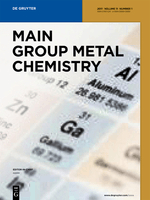
MAIN GROUP METAL CHEMISTRY
Innovating Materials Science through Metal ChemistryMAIN GROUP METAL CHEMISTRY, published by De Gruyter Poland Sp. z o. o., is an esteemed open access journal that has made a significant impact in the fields of Chemistry, Condensed Matter Physics, and Materials Science since its inception in 1988. With its ongoing publication aimed at advancing scholarly discourse until 2024, this journal is indexed in leading databases and has earned a diverse readership due to its rigorous peer-review process and relevant contribution to the understanding of metal chemistry. In the 2023 category quartiles, it has been recognized as Q2 in Metals and Alloys and holds Q3 rankings in Chemistry (miscellaneous), Condensed Matter Physics, and Materials Chemistry, showcasing its interdisciplinary appeal and recognition in the scientific community. The journal's innovative open access model, implemented in 2019, enhances visibility and accessibility for researchers worldwide, fostering collaboration and discovery among professionals, students, and academics alike. By presenting high-quality research and critical reviews, MAIN GROUP METAL CHEMISTRY serves as a vital resource for those seeking to deepen their understanding of metal interactions and their applications in advanced materials.

Inorganic and Nano-Metal Chemistry
Advancing Knowledge in Inorganic Chemistry and Nanotechnology.Inorganic and Nano-Metal Chemistry is a premier journal published by Taylor & Francis Inc, focusing on innovative research and advancements in the fields of inorganic chemistry and nano-metal applications. With an increasing impact in the academic community, this journal has established itself within the Q3 category of both Inorganic Chemistry and Physical and Theoretical Chemistry as of 2023, reflecting its global recognition and influence. The journal is accessible as an Open Access publication, ensuring that research findings are freely available to a broad audience, promoting transparency and collaboration in scientific exploration. Based in the United Kingdom, Inorganic and Nano-Metal Chemistry aims to disseminate high-quality peer-reviewed articles that not only highlight fundamental studies but also push the boundaries of technological applications in areas such as catalysis, materials science, and nanotechnology. Researchers, professionals, and students will find this journal an invaluable resource for the latest developments and interdisciplinary insights in the ever-evolving landscape of inorganic and nano-metal chemistry.

INORGANIC MATERIALS
Advancing Knowledge in Inorganic Materials ScienceINORGANIC MATERIALS, published by MAIK NAUKA/INTERPERIODICA/SPRINGER, is a pivotal journal in the realm of Materials Science, focusing primarily on the exploration and application of inorganic materials. With a robust commitment to advancing knowledge in areas such as Metals and Alloys, Inorganic Chemistry, and Chemical Engineering, this journal has successfully maintained a reputation for quality, achieving various category quartiles in 2023, including Q3 in Chemical Engineering and Materials Chemistry, and Q4 in Inorganic Chemistry. Although it operates under traditional access models, the journal welcomes contributions from researchers dedicated to understanding the properties and applications of inorganic substances. Throughout its publication history from 1996 to 2024, INORGANIC MATERIALS has become an essential resource for those engaged in innovative research and development, making it an invaluable tool for students, professionals, and academics alike.

Organics is a peer-reviewed journal dedicated to the advancement of research in the field of organic chemistry, published by MDPI, a renowned leader in open access publication. Since its inception in 2020, the journal has embraced an open access model, ensuring that cutting-edge research is freely available to researchers, professionals, and students worldwide. With a current impact factor reflecting its relevance in the community, Organics aims to provide a platform for high-quality research, reviews, and insights that foster innovation and collaboration in the organic chemistry domain. The journal's scope encompasses a broad range of topics within organic chemistry, making it an essential resource for those involved in various research endeavors. As it converges from 2020 to 2024, Organics is set to build on its solid foundation and enhance its scholarly contributions by attracting significant research contributions that align with the latest scientific developments. Based in Basel, Switzerland, the journal's commitment to quality and accessibility resonates strongly with today's research landscape, making it a pivotal asset for anyone invested in the future of organic chemistry.

Inorganics
Catalyzing Collaboration in Inorganic ResearchInorganics is a vibrant, peer-reviewed Open Access journal dedicated to advancing the field of inorganic chemistry, published by MDPI since 2013. Based in Switzerland, this journal aims to provide a dynamic platform for researchers, professionals, and students to share groundbreaking findings, fostering collaboration and innovation within the global scientific community. With an impressive Q2 ranking in the category of Inorganic Chemistry as of 2023, Inorganics stands out as a significant conduit for high-quality research that spans a wide range of topics from coordination compounds to metal-organic frameworks. Its commitment to accessibility ensures that cutting-edge research can be accessed, utilized, and built upon by a diverse audience, thereby amplifying its impact. Join the conversation in Inorganics and contribute to the ever-evolving landscape of inorganic chemical research.
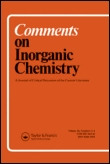
COMMENTS ON INORGANIC CHEMISTRY
Exploring the Depths of Inorganic ScienceCOMMENTS ON INORGANIC CHEMISTRY is a prestigious academic journal published by Taylor & Francis Ltd, specializing in the dynamic field of inorganic chemistry. With an impressive impact factor placing it in the Q1 category, this journal ranks #6 out of 79 in its field, reflecting its high influence and contribution to the discipline, with a remarkable percentile ranking of 93rd. Since its inception in 1981 and spanning publications until 2024, this journal serves as a crucial platform for researchers, professionals, and students to disseminate groundbreaking findings, review articles, and discussions on contemporary topics in inorganic chemistry. Although it is not an Open Access journal, the rigorous peer-review process ensures the publication of high-quality research. By bridging theoretical and practical aspects of inorganic chemistry, COMMENTS ON INORGANIC CHEMISTRY remains an essential resource for advancing knowledge and fostering innovation within the scientific community.